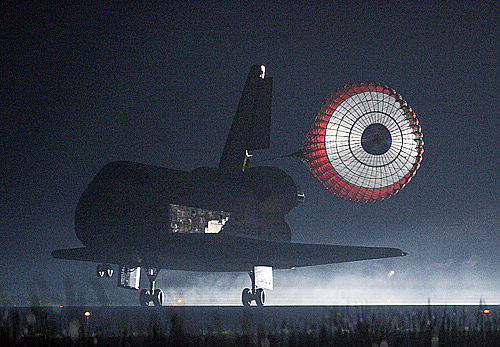|
 |
|
FINAL LANDING: Atlantis touches down in the pre-dawn hours at the Kennedy Space Center in Florida on July 21, marking its final mission (XINHUA/AFP) |
New vision
In recent years, the United States has focused on promoting the development of a more commercial manned space transportation system. In 2004, the George W. Bush administration outlined its plans for space exploration in the Vision for Space Exploration policy paper.
As per this vision, new manned launch vehicles and spacecraft will take over the responsibilities of the space shuttle. This next generation of vehicles is also intended to facilitate the United States' ambitions to return to the moon by 2020. However, a five-year lag is expected between the retirement of the shuttle and the development of a new manned space transportation system.
Anticipating a gap between its space transportation platforms, NASA proposed in 2005 that a commercial transportation system fulfill the task of taking deliveries to the International Space Station.
In 2006, NASA opened tenders for the development of its commercial orbit transportation service. Currently, two transportation systems are under development: the Falcon 9 launch vehicle/Dragon spacecraft and the Taurus II launch vehicle/Cygnus spacecraft. These private sector systems are scheduled to enter service in 2015. The Falcon 9 rocket, developed by the Space Exploration Technologies Corp., has made trial flights with the Dragon twice. The system can deliver a payload of 10.5 tons into the low-Earth orbit, at a launch price of only $45.8 million to $51.5 million. The Taurus II/Cygnus system, developed by the Orbital Sciences Corp., is scheduled to have its first launch later this year. It will be able to lift 5.75 tons into space.
The United States also plans to develop heavy launch vehicles to realize its ambitions of manned deep space exploration. In 2005, the Bush administration launched the Constellation Program with the aim of sending astronauts to the moon.
As part of this program, the United States began developing the Ares I crew launch vehicle, the Ares V cargo launch vehicle, the Altair lunar lander and the Orion manned spacecraft. The low-Earth launch capability of the Ares I was projected to be 25 tons, and the project's design incorporated a number of enhanced safety features.
But in 2010, faced with severe fiscal deficits, overspending and lagging progress, the Barack Obama administration cancelled the Constellation Program and gave up the development of the Ares launch vehicle.
The United States, however, has not given up its ambitions for manned space flight. In April 2011, Obama proposed the use of heavy-lift rockets to send astronauts to visit an asteroid by 2025. The current U.S. administration has also suggested the mid-2030s as an approximate date for sending astronauts to orbit Mars and returning them safely to Earth, and a landing on Mars will follow. A new generation of heavy-lift launch vehicles is now being developed, and these vehicles will have low-Earth orbit launch capabilities of 130 tons.
Despite ambitious future plans, for the time being the United States is without a regular low-Earth orbit manned transportation platform and hopes to use Russia's Soyuz spacecraft during this transition phase. The Soyuz is a much lower-cost platform than the space shuttle. NASA has ordered six seats on the Soyuz from 2013 to 2014, at a cost of $55.8 million per seat, and 12 seats from 2014 to 2015, at a cost of $62.7 million per seat.
Space exploration has become a collaborative affair. The United States now cooperates with Russia, Europe, India and Canada in different space-related fields. This new international approach has helped reduce costs.
 |
|
BON VOYAGE: A spectator cheers as Atlantis lifts off on July 8 (XINHUA/AFP) |
Today, only the United States, Russia and China possess the ability to send astronauts to the space. Assessing China's space program, the Review of U.S. Human Spaceflight Plans Committee said in a 2009 report, "China offers significant potential in a space partnership."
China has already developed the capacity for manned space flight and is now developing space rendezvous and docking capabilities. Despite its temporary suspension of manned space flights, the United States still leads the world in terms of space exploration. China has a long way to go, particularly in terms of space station construction and the development of a reusable launch system.
It is safe to say the U.S. space shuttle's retirement will provide opportunities for space technology cooperation between China and the United States.
Tong Yanchun is a researcher with the Beijing Institute of Aerospace Long March Scientific and Technical Information; Zhang Bing is a researcher with the Beijing Institute of Astronautic System Engineering | 